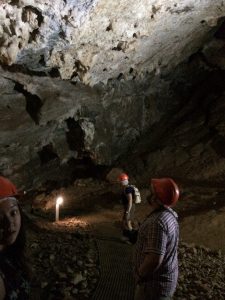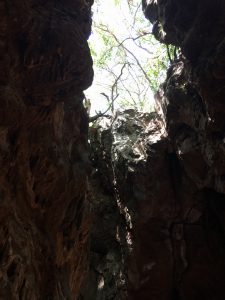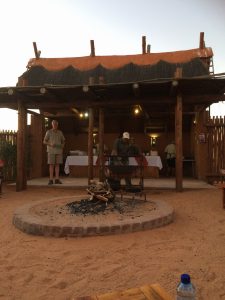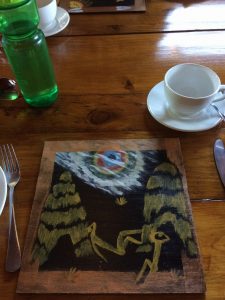Reflection Upon Return
I had been looking forward to applying to this course ever since Professor DeSilva had brought it up as a project he was very excited about, and after being fortunate enough to experience three amazing weeks all over South Africa, I was certainly not disappointed.
Although the material that we covered in class seemed expansive and perhaps even daunting (leading a class discussion on plant evolution and the evolution of different biomes was certainly outside of my sphere of knowledge), the trip really brought all of those seemingly loose ends together and made it clear that there is no better way to understand the Cradle of Humankind and origin of our species without really experiencing the place itself. And, what really impressed me about this course was its ability to tie together not only all branches of anthropology—the biological/physical, cultural, archaeological—but many outside fields as well. From digging at Malapa, to talking with the San/Bushmen, to gathering data from a museum collection, this trip went beyond me engaging with the material we discussed in class. It exposed me to the all questions and processes researchers go through to produce the nice summarized publications we print out at home and read at our leisure.
During the first component of the trip, I came to understand how it really takes a team to tackle a project. At Malapa, there were multiple people either digging, sifting, or documenting. I was particularly impressed by how meticulous the documentation process for each square of the site was. In addition to being photographed, each square was measured and drawn—every rock included. I will say that I found this a bit tedious and maybe even redundant given the fact that they were photographed. I was also disappointed that throughout our time at the field site, I did not spend much time digging because documenting took quite a bit of time and other students had already taken the positions. Despite this, I think the greatest showcase of teamwork was finding the pelvis fossil. Not only did the different stations collaborate in this discovery, but Lee Berger and Professor DeSilva analyzed the piece together to determine what it was. The discovery was very encouraging although we were warned that discoveries like those were rare and many researchers went years without finding fossils of significance. The site is either more fossiliferous than I expected, we are really lucky, or we are just that good.

What I found funny about these field sites was that I expected a lot of them to be very obvious caves on the side of a mountain or something of that sort. Instead, most were hardly visible until you were almost right before the opening—all of a sudden I realized why those sites had fossils in the first place and how the theories about ancient hominins falling in and becoming fossilized came about. I would have probably been one of those organisms if it were not for what Lee Berger referred to as "anti-stupidity fences" to keep people out and, most importantly, safe. But the unassuming or possibly even underwhelming appearance from the outset of these caves did not prepare me for the expansive and beautiful interior they contained. Sterkfontein was absolutely breathtaking with its high ceilings, massive interior rock formations, and waterways. Rising Star was equally impressive for exactly the opposite reasons. We had all seen videos of what it takes for someone to get to the Dinaledi Chambers and how some passages were so small you could not turn your head. We were not allowed to go any further than the main connecting chamber but already, I could sense how incredibly difficult it would be to get through! And Marina Elliot's story about her involvement in the project and how she even came to work in paleoanthropology was incredible and inspiring. Her presence really left a big impression on me and I am so glad I was able to hear her story from her.



The importance and impact of hearing a story first-hand cannot be understated. I think our stay at !Xaus Lodge was transformative and eye-opening for many on the trip—the stay certainly left me with many unsettled thoughts and feelings.

While it was comforting to hear that the San/Bushmen had some, although admittedly quite little, control over their representation, listening to how much they have struggled throughout the years only to obtain very little "help" from the South African government, was devastating. It makes you want to do something then and there because you realize how little power they have in running the lodge they own in name only. It makes you realize that you are there listening to their story and it may upset you, but at the end of the day, you are going home away from all of that and that the worst part is that the plight of many native peoples is not of great concern to the powers that govern the world. I felt powerless in the grand scheme of things and guilty because anthropology has historically played a role in determining "race" and exoticizing the Other. As anthropology students of some form or another, I feel like it is our duty to empower and speak for communities like these so loudly so that the room may become silent and listen to them speak for themselves. I also realized how projects can be riddled with normalized postcolonial attitudes and how problematic it is despite Western societies' intentions to help. I look forward to delving into this topic further during the Anthropology FSP in New Zealand next term.
In Cape Town I also got a glimpse of museum facilities and technologies for the preservation of many great paleoanthropological finds. While the fossils at the University of Witswatersrand had been generally maintained in a temperature-controlled room, organized into many different drawers and shelves, the museum collection in Cape Town did not experience the same conditions probably due to lack of funding to create and maintain such facilities. Additionally, one of the specimens we requested could not be found which was slightly troubling. As I learned, these kinds of problems are not uncommon in these museums because even though it pains me to say it, the government probably feels that it should devote its resources toward projects like public health and infrastructure more so than toward protecting our exciting and beautiful, but nonetheless dead, material.
I am extremely grateful for having had this experience. It made me more aware of the position, responsibility, and privilege that I have as a global citizen. It also made me really appreciate the creativity and risk researchers take when tackling a new project. But most importantly, the professors, the researchers, the people we met along the way, taught me to really give your all to the things that you love to do. They taught me that paths are seldom straight and direct but if you keep your mind open, you can find new opportunities you never even imagined hidden in those twists and turns.
